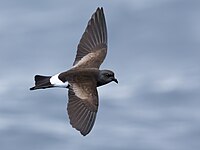
Photo from wikipedia
Understanding of the drivers and effects of exposure to contaminants such as mercury (Hg) and organochlorine compounds (OCs) in Antarctic wildlife is still limited. Yet, Hg and OCs have known… Click to show full abstract
Understanding of the drivers and effects of exposure to contaminants such as mercury (Hg) and organochlorine compounds (OCs) in Antarctic wildlife is still limited. Yet, Hg and OCs have known physiological and fitness effects in animals, with consequences on their populations. Here we measured total Hg (a proxy of methyl-Hg) in blood cells and feathers, and 12 OCs (seven polychlorinated biphenyls, PCBs, and five organochlorine pesticides, OCPs) in plasma of 30 breeding female Antarctic petrels Thalassoica antarctica from one of the largest colonies in Antarctica (Svarthamaren, Dronning Maud Land). This colony is declining and there is poor documentation on the potential role played by contaminants on individual physiology and fitness. Carbon (δ13C) and nitrogen (δ15N) stable isotope values measured in the females' blood cells and feathers served as proxies of their feeding ecology during the pre-laying (austral spring) and moulting (winter) periods, respectively. We document feather Hg concentrations (mean ± SD, 2.41 ± 0.83 μg g-1 dry weight, dw) for the first time in this species. Blood Hg concentrations (1.38 ± 0.43 μg g-1 dw) were almost twice as high as those reported in a recent study, and increased with pre-laying trophic position (blood δ15N). Moulting trophic ecology did not predict blood Hg concentrations. PCB concentrations were very low (Σ5PCBs, 0.35 ± 0.31 ng g-1 wet weight, ww). Among OCPs, HCB (1.02 ± 0.36 ng g-1 ww) and p, p'-DDE (1.02 ± 1.49 ng g-1 ww) residues were comparable to those of ecologically-similar polar seabirds, while Mirex residues (0.72 ± 0.35 ng g-1 ww) were higher. PCB and OCP concentrations showed no clear relationship with pre-laying or moulting feeding ecology, indicating that other factors overcome dietary drivers. OC residues were inversely related to body condition, suggesting stronger release of OCs into the circulation of egg-laying females upon depletion of their lipid reserves. Egg volume, hatching success, chick body condition and survival were not related to maternal Hg or OC concentrations. Legacy contaminant exposure does not seem to represent a threat for the breeding fraction of this population over the short term. Yet, exposure to contaminants and other concurring environmental stressors should be monitored over the long-term in this declining population.
Journal Title: Environmental research
Year Published: 2020
Link to full text (if available)
Share on Social Media: Sign Up to like & get
recommendations!